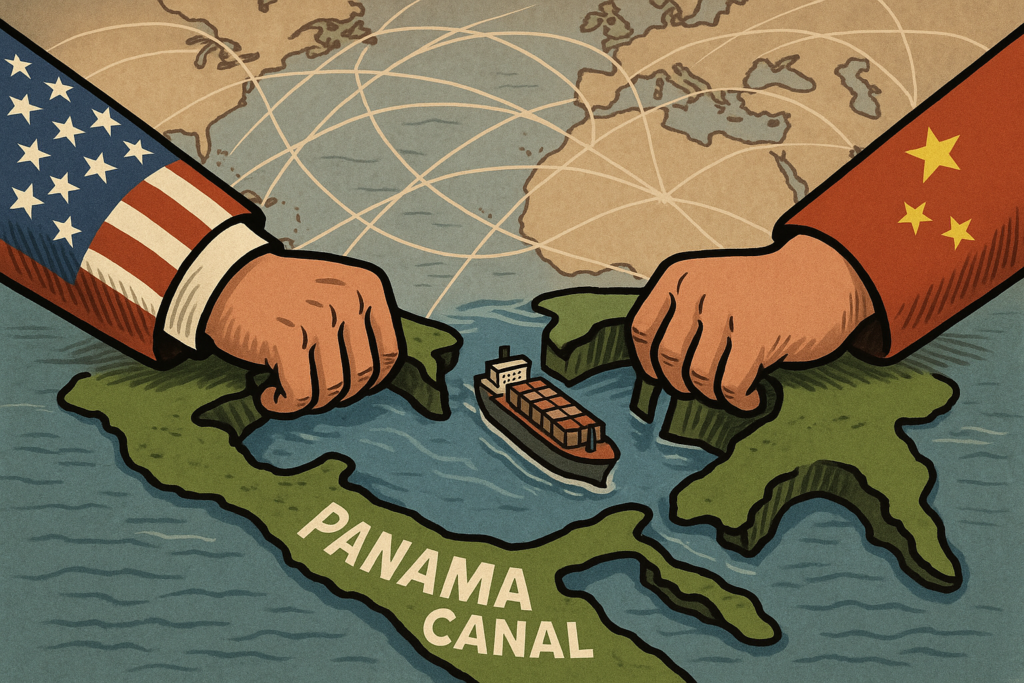
- The Panama Canal alone handles around 5% of global maritime trade annually, highlighting its strategic and economic significance for both Panama and the world.
- For Washington, the canal remains vital, about 75% of its commercial traffic involves U.S. ports, and nearly 40% of all American container shipments, including energy exports to Asia, pass through it annually.
- President José Raúl Mulino has unequivocally rejected Trump’s statements, stating that there is “no possibility of reopening any discussion on canal ownership,” and affirming that the canal is operated exclusively by Panamanians.
Maritime trade and sea routes play a vital role in shaping the global economy and strengthening national security, making ports, canals, and shipping lanes central to every nation’s foreign policy strategy. For instance, the Panama Canal alone handles around 5% of global maritime trade annually, highlighting its strategic and economic significance for both Panama and the world.
This is why China continues to invest heavily in seaports and canals through its large-scale initiatives, while the United States works to counter Beijing’s expanding maritime ambitions. U.S. concerns intensified after Chinese naval vessels docked at the Piraeus Port in Europe in 2017 during a “friendship visit” by senior Chinese officials, signalling the potential military use of commercial ports.
As Robert Poole-Robb from KCS noted, “The U.S., in the short to medium term, is likely to continue its efforts to counter Chinese influence in key port areas by building alliances and partnerships to challenge Chinese power and economic growth.” The U.S. focus on the Panama Canal represents one of its most ambitious efforts to expand maritime influence since the 1970s, reflecting concerns in Washington that China could gain a strategic advantage in the event of conflict.
Background
China is the world’s largest trading nation and the second-largest economy, with nearly 95 % of its trade conducted via maritime routes. Since 2013, President Xi Jinping’s Belt and Road Initiative (BRI) and the 21st Century Maritime Silk Road, which links China to Europe and the Arctic through the South China Sea and Indian Ocean, have accelerated Beijing’s global investments in port development and maritime infrastructure projects.
President Xi has repeatedly stressed the importance of ports for economic growth, saying, “To get rich, we must first build roads; but in coastal areas, we must also first build ports.” This strategy has paid off. Shanghai has remained the world’s busiest container port for over thirteen consecutive years, and several of China’s ports rank among the most connected globally, symbolising its growing dominance in maritime trade.
Why It Remains in the News
Under Donald Trump’s presidency, the U.S. launched a campaign to reduce China’s global port presence and bring key maritime infrastructure under Western control. Trump often emphasised the need to “reclaim” the Panama Canal, expressing concern over Chinese investments and growing influence in the region.
For Washington, the canal remains vital, about 75% of its commercial traffic involves U.S. ports, and nearly 40% of all American container shipments, including energy exports to Asia, pass through it annually. Any disruption or foreign control of the canal would significantly impact global trade and deal a major blow to the U.S. economy.
China’s Aspirations Behind the Panama Canal
For Beijing, initiatives such as the Belt and Road Initiative(BRI) and the Maritime Silk Road constitute the backbone of its global connectivity strategy. Through these efforts, China aims to expand its trade networks by constructing roads, railways, and ports across the world. At present, China maintains port-related projects on nearly every continent except Antarctica. Of more than 130 such projects, approximately 115 remain active, while 14 were suspended or cancelled as of July 2024.
China asserts that these initiatives are intended to promote mutual development and global prosperity, in alignment with international laws and trade regulations. Chinese investments, channelled through BRI and state-owned banks, have enabled many countries to improve their infrastructure and enhance trade capacity. Beijing maintains that it is working to reduce global infrastructure gaps, whereas Washington characterises these efforts as part of a broader geopolitical challenge.
China further argues that due to climate change, rising sea levels, increasing cargo volumes, and shifting ocean patterns, investing in modern port and canal technology has become essential for global trade. According to Beijing, these investments are aimed at improving efficiency and serving the interests of the international community, not undermining any country’s security.
Why the Panama Canal is Important to the United States
The Panama Canal holds profound strategic, economic, and historical significance for the U.S. It was constructed by Americans and remained under U.S. control for decades until 1977, when President Jimmy Carter signed the Torrijos–Carter Treaties, which transferred ownership to Panama. This history explains why Trump often described the handover as a mistake and voiced a desire to reclaim control.
The canal is equally vital to Panama’s economy, contributing nearly 4% of its GDP. As analyst Will Freeman of the Council on Foreign Relations stated, “Trump seems to be making an example out of Panama, aiming to deter other Latin American leaders from deepening ties with Beijing.” Consequently, the canal has become a strategic symbol in the broader U.S.–China competition across Latin America.
Can the Canal Be Used as a Military Threat in the Future?
Although Chinese investments may not pose an immediate economic risk to the United States, Washington’s primary concern lies in the potential militarisation of Chinese-operated ports. U.S. policymakers fear that Beijing could eventually repurpose these commercial facilities for military use, thereby shifting global power dynamics.
From a realist perspective, such concerns are understandable. When a state gains financial and political control over critical infrastructure, it often acquires the capacity to leverage these assets strategically in the future. This is the challenge the U.S. seeks to avert before it becomes a reality.
China maintains that it is merely modernising infrastructure to meet evolving trade demands, emphasising that when the U.S. undertakes similar projects, they are regarded as normal, whereas China’s actions are often perceived as threatening.
Panama’s View
The Panamanian government firmly denies that the canal is under Chinese control, asserting that such claims undermine Panama’s sovereignty. President José Raúl Mulino has unequivocally rejected Trump’s statements, stating that there is “no possibility of reopening any discussion on canal ownership,” and affirming that the canal is operated exclusively by Panamanians. He also stressed that shipping fees are applied equally to all countries.
Still, domestic opinion in Panama remains divided. Some critics contend that President Mulino is aligned with the United States and maintains close ties with Trump, arguing that U.S. statements hurt national pride and reflect a disregard for Panama’s sovereignty. However, since Panama joined the Belt and Road Initiative and welcomed Chinese investment, Trump’s remarks have gained greater attention and significance in the U.S.
The Panama Canal could soon emerge as a potential flashpoint in the U.S.–China rivalry. A stronger American presence in the region, or any effort to restrict Chinese trade, could represent both a strategic advantage and a potential catalyst for conflict.
As Chinese investment in Panama continues to expand, Washington increasingly perceives it as a direct challenge to its influence over global trade routes. If the canal’s operations were ever disrupted, the impact would reverberate across the global economy, and the U.S. would bear the greatest losses due to its heavy reliance on this vital maritime passage. This dynamic helps explain why the U.S.seeks to ensure that the canal remains under Western-aligned management. The underlying fear is that China could, in the event of a conflict, transform the canal into a strategic chokepoint, thereby reshaping global maritime power dynamics and escalating the competition for dominance between the two major countries.
Garima Sharma is a Master’s student in International Relations at Jawaharlal Nehru University. Her interests include public policy, international governance, geopolitics, defence, and security. Views expressed are the author’s own.
